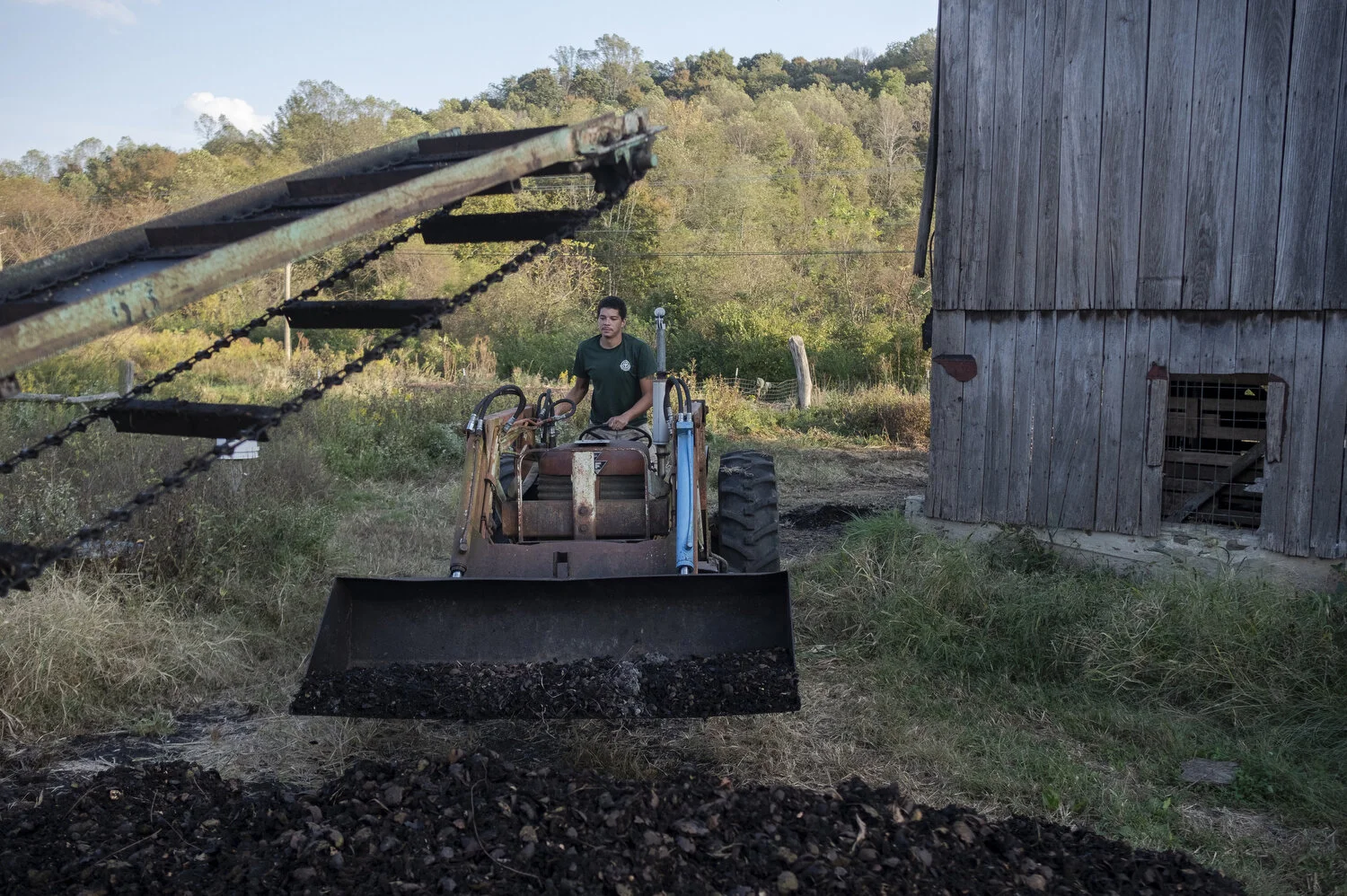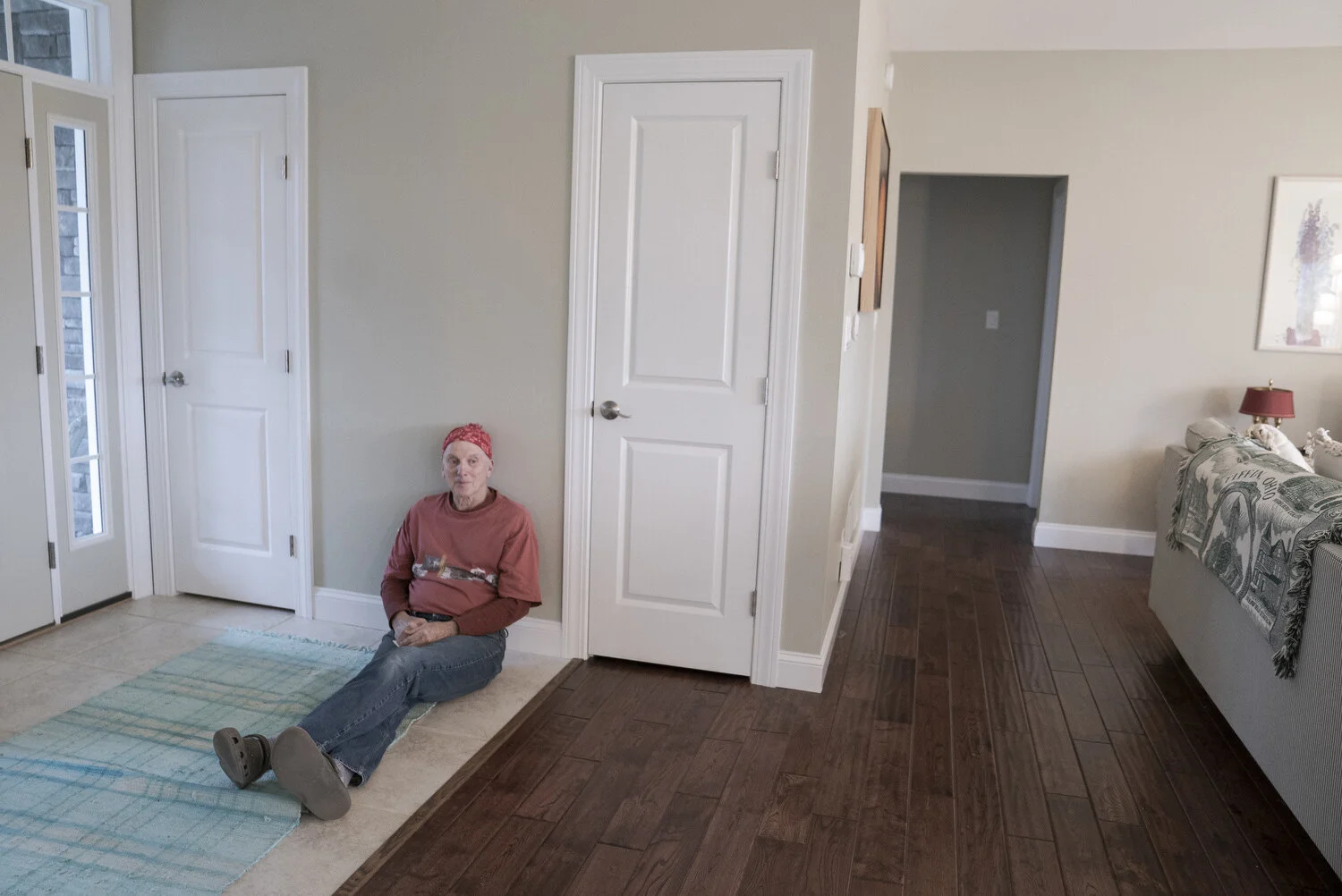
Maggi Gifford and her grandson Hunter Blosser, 13, park outside the library in Glouster, Ohio, to use the Wi-Fi. As Americans anticipate the arrival of 5G wireless technology—with superfast data-transmission speeds expected to enable everything from superior home internet service to long-imagined technological advances like self-driving cars—it’s easy to forget that millions of people across the U.S. still have no broadband internet access in their homes. According to a 2019 Federal Communications Commission report, 21.3 million Americans lacked a broadband internet connection at the end of 2017.
(Published in The Wall Street Journal)

The documentary “Do Not Pass Go” is screened at the Athens Public Library, about the efforts of a community in North Carolina to obtain widespread, fast, reliable internet service. This lack of access isn’t just about not being able to play the latest videogames online or stream movies on a phone. For people without broadband connections, it’s much harder to do things like conduct research for schoolwork, grow their own businesses or even find work online.

Greg Hall reacts as his internet connection fails 20 minutes before he is supposed to closed-caption a live broadcast TV program at his home in Pomeroy, Ohio. It sputters back to life minutes before his shift begins. This was before a local provider, Intelliwave, upgraded his package in August 2019 when he was recognized as a business because he works from home. Yet if he did not live on a hill, the satellite connection would not have been able to reach.

Mr. Hall paid for two megabits of upload speed and one download for 11 years but rarely got that much.

Libby Hall, 13, steps off the school bus for home. Until recently, she traveled 30 minutes with her mother after school to Ohio University where she could use the internet for schoolwork.

Libby and her mother Juanita Hall, a professor at Ohio University who is deaf, commuted nearly 14 years to Ohio University and the Athens Public Library for high-speed internet access. Mr. Hall required the lion’s share on the internet in their household as a closed-caption writer for live TV.

The Hall family can now access internet at the same time, but it costs about three times more than their previous setup.

Elijah Byrd, 16, a junior at Federal Hocking High School, does research for his homework on his cellphone. His mother can’t afford to spend $100 a month on internet, so his grandmother buys him a $55 unlimited data card each month, and Elijah then types his homework up on his Chromebook.

Mr. Byrd rubs his eyes while doing homework. For a journalism paper, he researched a website that didn't have a mobile version and struggled to read the information on his phone. He gave up in frustration and turned in the paper with minimal research done.

Mr. Byrd carries then-girlfriend Isis Mayle, 17, across his yard in Millfield, Ohio.

Jay and Annie Warmke live in a home made from mud, tires, wood, glass bottles and cans in Philo, Ohio. Internet was a new concept when they bought the land in 1996, so they didn’t foresee their personal need for it. The lack of broadband at home makes spreading their teaching methods for sustainable living more difficult. To upload or download files or conduct video calls they travel to a nearby library with Wi-Fi.

Mr. Warmke waits to welcome visitors for an “Earthship Tour” of the couple's property. After the construction of their home was complete, they published a newspaper story, and the next day over 400 people showed up. They stopped counting their visitors after the total reached 35,000 in 2004.

Visitors tour the Warmke’s 40-acre sustainability center called Blue Rock Station.

Ms. Warmke milks the goats and feeds the chickens.

One of Mr. Warmke’s responsibilities working for the International Certification Accreditation Council is to assess solar-industry certification programs. More often than not, this is done remotely, so he has conducted international videoconference calls from his car parked outside the library after it has closed.

Mr. Warmke conducts a business call while the internet runs slowly in his home. An expert on solar technology, he has taught over 400 students who became certified solar installers. He would like to offer training courses online with a virtual-reality component to simulate installation. This is impossible with his current internet connection. “If your motivation was to promote the economic activity in rural America, this would be the place you would start,” he says. “There’s a lot of us—we’re just not clustered in one location.”

Every morning the Warmkes sit outside their home and talk over his coffee and her tea. "If you talk to people who have access to internet, immediately it's a nonissue, 'cause it's like, 'Well, that's weird, I have it,' " says Mr. Warmke.

The sun rises in Pomeroy, Ohio.

Nestled between idyllic meadows and rolling hills in Pomeroy, Ohio, is the Snowville Creamery dairy farm. In the 10 years since it was established, the business has grown, and its milk, yogurt and cheese products are now available at Whole Foods stores in several states on the East Coast and in the Midwest.

If the farm had access to broadband, its owners could process data from bar codes on the company’s products as orders are fulfilled, allowing the farm to streamline shipping and inventory tracking and make mistakes less likely. On days when their current service is particularly slow, people working on the company’s computers can spend an extra hour or more waiting for the internet to load, which ultimately costs the business more.

Currently, employees hand count each item, as they load them into boxes and onto pallets for shipment, a time-consuming process that “frequently leaves room for error,” says Tapan Alam, an engineer at Snowville Creamery.

The randomness of who gets connection mostly depends on whether fiber optic wire is laid near your property or if there is a tower nearby that allows you to connect wirelessly, but the terrain in rural areas often blocks a clear reception.

Nate Myers, an employee at the sustainable farm Integration Acres in Albany, Ohio, hulls black walnuts. The farm sells several other products online, but without broadband, productivity is hindered when processing orders and communicating with customers. Myers’ wife and some of her friends say they could boost their income if they had broadband access that would allow them to work from home.

Megan Ogle, an employee at Integration Acres, milks goats. There is also an Airbnb on the property, but interested guests sometimes back out when they learn that it has no internet connection.

The home of Tim Traxler and Cathy Sitko lies several miles down Highway 550, around a mile-and-a-half curvy road that feels like an endless driveway and finally up a steep gravel path. Deep in the woods, their home feels like a safe haven from civilization.

Mr. Traxler and Ms. Sitko pay for 25 Mbps upload—the standard for broadband—but only get about 15 Mbps. Sitko still relies on her phone most of the time. They still order Netflix DVDs because streaming is not an option. “I’ve adjusted,” she says.

"One day we just didn’t have any internet, and then another day went by and another day,” said Ms. Sitko.

Traxler helps decorate their first Christmas tree in over a decade. They were told by an internet company that in order to have a clear signal on their property, they must cut down two of their 80-foot trees. After the trees were removed, the company said those were the wrong trees. Unnecessarily destroying trees "was like cutting off his arm," said Ms. Sitko.

Bill Krotzer moved from California to Athens, Ohio, to care for his sister with breast cancer. After he bought a house and moved in, he discovered that he cannot get internet. One month later, his sister died.

A couple times a week, Mr. Krotzer drives to the library for connection. He is too drained emotionally and financially to move back to California. His street in Ohio has similarities to his old neighborhood: both have twelve houses with little traffic and friendly neighbors. But socially, this haven of peace feels isolated without broadband. “I didn’t even think about not having it [Wi-fi],” he says. “It’s like water.” Back home, he flourished with 60 megabits of speed – an invisible window into the world of connectivity.

Libraries in southeastern Ohio are the lifeblood of internet connectivity for people of all generations to study, communicate and work. While companies have the ability to build the infrastructure to expand broadband access, there is little financial incentive to do so in rural areas with only a handful of users.































